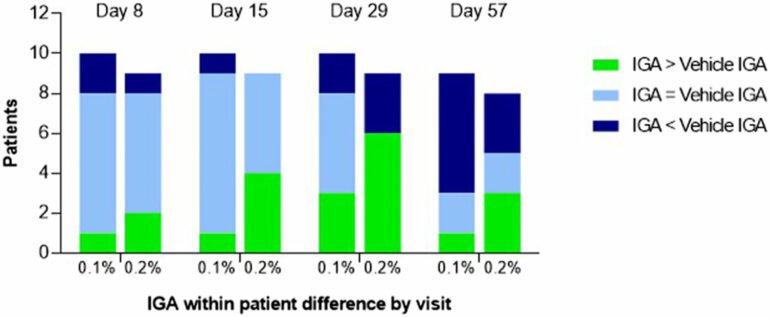Peyton Fleagle was just a toddler when his parents first noticed itchy scales appear on his skin. Eventually, the scales covered 95% of Peyton’s body.
Fleagle, who is now 12, has a condition called X-linked ichthyosis, one of an often-disfiguring group of skin diseases that develop in children.
Known collectively as congenital ichthyosis, the diseases are characterized by dry, scaly patches of skin that cover the body. Ichthyosis affects the way the skin regenerates, either by slowing down the shedding of old skin cells or speeding up the formation of new skin cells. There is currently no treatment for ichthyosis approved by the U.S. Food and Drug Administration.
But that might change.
Yale is a testing site for a potential new remedy—an ointment developed by Timber Pharmaceuticals. The treatment works by affecting retinoic acid receptors in the nucleus of skin cells. The treatment normalizes the turnover of skin cells so that there is less retention of old cells and less hyperactivity of skin production.
For Peyton Fleagle, who is part of a phase three clinical trial for the new treatment at Yale New Haven Hospital, the signs are encouraging. He experienced dramatic results as a participant in the previous clinical trial for the ointment.
“It was like magic,” said his mother Christina Fleagle, who lives in Agawam, Massachusetts. “His skin completely cleared up. All the scales were gone.”
“When I’m not itching, I just feel different. I feel better, because I’m not constantly scratching,” Peyton said.
Christopher Bunick, associate professor of dermatology at Yale School of Medicine and principal investigator for clinical trials of the new treatment at Yale, said Peyton’s experience is not unique.
“Several of my patients have seen transformative results, where their scale is entirely clear, the skin clear for the first time. It is remarkable,” Bunick said. “The studies show that when patients use the medicine as indicated, most of them show improvement. It is not a cure, however.”
Bunick is corresponding author of a trio of studies, including one that will soon be published, reporting the results of the clinical trials. Bunick also presented the trial results at a meeting of the American Academy of Dermatology last year.
The studies looked at phase two clinical trials (there are three phases of trials before potential FDA approval) focused on the safety, tolerability, and efficacy of the new medicine for treating patients.
The first study, in the Journal of the American Academy of Dermatology (JAAD), featured 19 patients and tested two concentration levels of the treatment for safety and tolerability. Both concentrations were found to be safe, but the lower concentration proved to be more efficacious.
The second study, also published in JAAD, included 33 patients and focused on the effectiveness of the treatment using two main measures: the Visual Index for Ichthyosis Severity (VIIS) scale system, which was developed by Keith Choate, chair of Yale’s Department of Dermatology, and the Investigator Global Assessment (IGA) score, a five-point scale of disease status for a range of diseases. All patients who received a 0.05% concentration of the treatment saw a 50% reduction in VIIS and two or more levels of improvement in IGA.
The most recent study, which has been accepted by the journal Clinical and Experimental Dermatology, focused on the effectiveness of the new medicine for treating two specific types of congenital ichthyosis: lamellar ichthyosis and X-linked recessive ichthyosis. The researchers found that the treatment worked equally well in both disease types, with all patients meeting the VIIS and IGA goals.
Yale’s involvement in the clinical trials—it is the only U.S. site involved in all three trials—is just the latest example of the university’s prominence in ichthyosis research. Emeritus professor of dermatology Leonard Milstone launched an ichthyosis clinic at Yale more than 20 years ago. In 2017, Keith Choate founded an ichthyosis registry at Yale and—with Milstone and other colleagues—developed the VIIS scale system.
“The deep roots of ichthyosis research and clinical care at Yale, and now via the clinical trials, are on the verge of helping bring to ichthyosis patients the first FDA-approved medication,” Bunick said.
Many of those patients, Bunick said, experience emotional and psychosocial trauma in addition to the disease’s physical effects.
“From a young age patients must endure chronic fissured and scaly skin, often red and inflamed as well, making them targets for jokes or bullying at school,” Bunick said. “These patients are always ‘different’ due to their appearance. They have constant shedding of scales in their bedding, their clothing—parents endure that, too.”
For the Fleagle family, ichthyosis has meant a decade of worry, frustration, Epsom salt baths, creams, and oils. Christina Fleagle said other family members, including her father and uncle, also have X-linked ichthyosis, but son Peyton’s case is by far the most severe.
“His skin gets so dry, especially in the winter when the heater is running, that it feels like tissue paper and has these red lines,” Christina Fleagle said. “Peyton used to call it ‘cracking.'”
Bunick said ichthyosis also makes wound healing more complicated for patients, who are prone to infection and slow healing.
The next step in Bunick’s research will focus on the phase three clinical trial at Yale, which is actively enrolling participants. Bunick also lauded the contributions of Mahin Dawood-Saffa and Nicole Olszewski for their work with the Yale Center for Clinical Investigation to manage various stages of the trials.
More information:
Amy S. Paller et al, Safety, tolerability, and efficacy of a novel topical isotretinoin formulation for the treatment of X-linked or lamellar congenital ichthyosis: Results from a phase 2a proof-of-concept study, Journal of the American Academy of Dermatology (2022). DOI: 10.1016/j.jaad.2022.02.060
Joyce M.C. Teng et al, The CONTROL study: A randomized, double-blind vehicle-controlled phase 2b study of novel topical isotretinoin formulation demonstrates improvement in recessive X-linked and autosomal recessive lamellar congenital ichthyosis, Journal of the American Academy of Dermatology (2022). DOI: 10.1016/j.jaad.2022.07.028
Citation:
Dermatologists test a promising treatment for skin diseases that often target children (2023, February 10)



